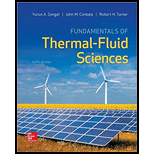
(a)
The COP of the heat pump.
(a)
Explanation of Solution
Given:
The initial pressure of the heat pump
The initial temperature of the heat pump
The mass flow rate of heat pump is
The final pressure of the heat pump
The quality of the refrigerant at the exit is 0 (saturated liquid).
The rate of required input of the heat pump
Calculation:
Convert the unit of pressure from kPa to MPa.
Refer to Table A-13, “Superheated refrigerant-134a”, obtain the below properties at the superheated pressure and temperature of 800 kPa (0.80 MPa) and 35 C using interpolation method of two variables.
Show the temperature at 31.31 C and 40 C as in Table (1).
| Temperature, C | Specific enthalpy, |
| Saturated liquid, | |
| 31.31 C | 267.34 |
| 35 C | ? |
| 40 C | 276.46 |
Calculate superheated pressure and temperature of 800 kPa (0.80 MPa) and 35 C for liquid phase using interpolation method.
Here, the variables denote by x and y are superheated temperature and specific enthalpy.
Substitute
From above calculation the initial enthalpy
Refer to Table A-12, “Saturated pressure table”, at final state of 800 kPa and 0.
Write the expression for the energy balance equation.
Here, the total energy entering the system is
Simplify Equation (II) and write energy balance relation of refrigrent-134a.
Here, The heat rejected in the condenser is
The initial specific enthalpy of the condenser is
Substitute
Write the expression for the rate of coefficient performance of a heat pump.
Thus, the COP of the heat pump is
(b)
The rate of heat absorbed from the outside air.
(b)
Explanation of Solution
Write the expression for the rate of conversation of energy principle for refrigerant 134a.
Thus, the rate of heat absorbed from the outside air is
Want to see more full solutions like this?
Chapter 7 Solutions
Fundamentals of Thermal-Fluid Sciences
- The inside temperature of a wall in a dwelling is 19°C. If the air in the room is at 21°C, what is the maximum relative humidity, in percent, the air can have before condensation occurs on the wall?arrow_forwardThe inside temperature of a wall in a dwelling is 19°C. If the air in the room is at 21°C, what is the maximum relative humidity, in percent, the air can have before condensation occurs on the wall?arrow_forward###arrow_forward
- Find the closed loop transfer function and then plot the step response for diFerentvalues of K in MATLAB. Show step response plot for different values of K. Auto Controls Show solution for transform function and provide matlab code (use k(i) for for loop NO COPIED SOLUTIONSarrow_forwardThis is an old practice exam. The answer is Ta-a = 4.615 MPa max = 14.20 MPa Su = 31.24 MPa Sus = 10.15 MPa but why?arrow_forwardThis is an old practice exam. The answer is dmin = 42.33 mm but how?arrow_forward
- 5.) 12.124* - Block B (WB = 12 lb) rests as shown on the upper surface of wedge A (W₁ = 30 lb). The angle of the slope is 0 = 30°. Neglect friction, and find immediately after the system is released from rest (a) the acceleration of a (a) and (b) the acceleration of B relative to A (a B/A).arrow_forwardWhat is the Maximum Bending Moment induced in the following Beam, if? P = 19 KN L = 11 m Ensure that your answer is in kN.m. لا اللهarrow_forwardWhat is the Magnitude of the Maximum Stress in the beam below if? W。 = 6 kN/m L = 9 m Beam width, b = 226 mm Beam Height, h = 273 mm Give your answer in MPa. A 233 B 4|3 Woarrow_forward
- What is the Reaction Force induced in the following system at point A, if? W = 12 kN/m P = 35 kN L = 11 m Ensure that your answer is in kN. ولها A 4/2 ↓↓ P Barrow_forward180- Dimensions in mm 100 100 D E Steel B Brass 60 kN 40 kN 40-mm diam. 30-mm diam. PROBLEM 2.40 Solve Prob. 2.39, assuming that rod AC is made of brass and rod CE is made of steel. PROBLEM 2.39 Two cylindrical rods, one of steel and the other of brass, are joined at C and restrained by rigid supports at A and E. For the loading shown and knowing that E = 200 GPa and E, 105 GPa, determine (a) the reactions at A and E, (b) the deflection of point C. = R = 45.5 kN ← Aarrow_forwardDimensions in mm 100 100 -180- -120-+- C D Steel B Brass 60 kN 40 kN 40-mm diam. 30-mm diam. E PROBLEM 2.39 Two cylindrical rods, one of steel and the other of brass, are joined at Cand restrained by rigid supports at A and E. For the loading shown and knowing that E = 200 GPa and E₁ = 105 GPa, determine (a) the reactions at A and E, (b) the deflection of point C.arrow_forward
 Elements Of ElectromagneticsMechanical EngineeringISBN:9780190698614Author:Sadiku, Matthew N. O.Publisher:Oxford University Press
Elements Of ElectromagneticsMechanical EngineeringISBN:9780190698614Author:Sadiku, Matthew N. O.Publisher:Oxford University Press Mechanics of Materials (10th Edition)Mechanical EngineeringISBN:9780134319650Author:Russell C. HibbelerPublisher:PEARSON
Mechanics of Materials (10th Edition)Mechanical EngineeringISBN:9780134319650Author:Russell C. HibbelerPublisher:PEARSON Thermodynamics: An Engineering ApproachMechanical EngineeringISBN:9781259822674Author:Yunus A. Cengel Dr., Michael A. BolesPublisher:McGraw-Hill Education
Thermodynamics: An Engineering ApproachMechanical EngineeringISBN:9781259822674Author:Yunus A. Cengel Dr., Michael A. BolesPublisher:McGraw-Hill Education Control Systems EngineeringMechanical EngineeringISBN:9781118170519Author:Norman S. NisePublisher:WILEY
Control Systems EngineeringMechanical EngineeringISBN:9781118170519Author:Norman S. NisePublisher:WILEY Mechanics of Materials (MindTap Course List)Mechanical EngineeringISBN:9781337093347Author:Barry J. Goodno, James M. GerePublisher:Cengage Learning
Mechanics of Materials (MindTap Course List)Mechanical EngineeringISBN:9781337093347Author:Barry J. Goodno, James M. GerePublisher:Cengage Learning Engineering Mechanics: StaticsMechanical EngineeringISBN:9781118807330Author:James L. Meriam, L. G. Kraige, J. N. BoltonPublisher:WILEY
Engineering Mechanics: StaticsMechanical EngineeringISBN:9781118807330Author:James L. Meriam, L. G. Kraige, J. N. BoltonPublisher:WILEY





